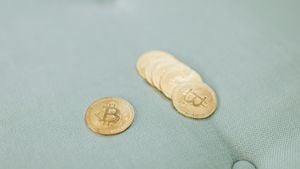A remarkable stride has been achieved at the Fukushima Daiichi nuclear power plant, where a remote-controlled robot has successfully retrieved the first piece of melted fuel since the catastrophic meltdown of 2011. This milestone was confirmed by the Tokyo Electric Power Company Holdings (TEPCO), marking a significant step forward in the long and complex process of decommissioning the troubled facility.
The robot, aptly named Telesco, is equipped with a fishing rod-like arm. It managed to extract a tiny sample approximately the size of a grain of gravel, measuring about 5 millimeters—equivalent to 0.2 inches—from the surface of debris at the bottom of the No. 2 reactor's primary containment vessel. After safely collecting this morsel of radioactive material, the robot returned to its designated container, where workers clad in full hazardous materials (HAZMAT) suits took precautions to secure the sample.
This operation is not simply about collecting rubble; it's pivotal for assessing the state of melted fuel and planning the plant's decommissioning strategy. TEPCO officials stated this extraction is the first of its kind since the meltdown, which has left approximately 880 tons of highly radioactive fuel trapped within the reactors.
Despite the achievement, challenges remain. The mission, which began earlier this summer, faced numerous delays. Initially projected as two weeks, the timeline extended due to procedural errors and equipment failures. TEPCO had to pause operations when Telesco's dual cameras—which are integral for providing operators with visual feedback—failed, necessitating repairs before the robot could resume its delicate task.
Once retrieved, the sample must undergo rigorous testing to determine if its radioactivity is within acceptable limits. If the radioactive levels exceed the threshold, the robot will have to return to collect another sample. TEPCO representatives are optimistic about the current sample's compliance and assert it should be manageable.
A notable point of focus is the significance of this sample. Akira Ono, the plant chief, explained the importance of tiny spec samples like this for gathering data. This information will not only assist with creating effective decommissioning strategies but will also contribute to developing the necessary technology and robotic systems needed to manage the complex removal process.
The Fukushima disaster is one of the most severe nuclear accidents in history, triggered by the devastating tsunami and earthquake on March 11, 2011. This disaster resulted in the meltdowns of three reactors at the plant, with long-lasting consequences for Japan and beyond. The precarious fuel situation at Fukushima is complex, and the cleanup is expected to take between 30 to 40 years—a projection many experts challenge as being overly optimistic. Currently, no definitive plans have been set for the complete removal of the nuclear fuel debris, leaving significant uncertainties about future actions.
Despite the arduous path lying ahead, this milestone showcases technological progress and the relentless effort to understand and mitigate the impacts of the Fukushima disaster. It highlights the potential for robotics to play an increasingly central role in salvaging the remnants of nuclear disasters, paving the way for safer environments and decommissioning strategies.
While the small sample collected may not seem like much, each step is pivotal to shaping future strategies for decommissioning one of the world's most challenging nuclear disaster sites. Continued advancements and robotic initiatives will be necessary as TEPCO works to responsibly navigate the significant hurdles posed by the wreckage of Fukushima Daiichi.



